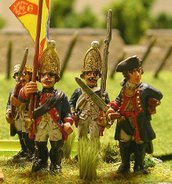You'll notice some battle damage not shown in my previous post. I thought about adding some machine gun holes using the laser, but I feared that the pieces would become too regular that way. Instead I opted to allow the modeler to add their own. Machine gun holes can be added with a small drill or by simply spinning the tip of your hobby knife. Larger caliber holes I made with a cone-shaped rotary tool grinding bit. I think both types add character to the piece. My only regret is I didn't add any to the inside walls. The last photo shows a Flames of War command stand inside the ruin to give a sense of scale to the piece.

Steppes House (2)
Back in April I posted my first attempt at making a 15mm steppes house for use in Flames of War games. That first attempt was way out of scale for 15mm. In fact it was pretty much spot on for 28mm scale so I gave it to my friend Byron as a gift for use in his Russian Civil War games.
This is my second attempt. I re-used the original CAD files and re-scaled them down to what I think is a proper 15mm scale. Instead of the three full stands of infantry the original held, this one holds a single stand of infantry, two command stands or if you want to let your bases overlap about 1/8" you can fit a stand of infantry and a command stand as shown in the photo below.
As in the first version, the thatched roof is made from synthetic 'teddy bear fur' material which is attached to the removable roof with contact cement, then saturated with white glue. After dry the roof was painted a base color using spray paint followed by two passes of dry-brushing to bring out the detail. The window and door frames are made with my laser from 1/64" plywood and glued in place. After that the entire building was given a light coat of textured spray paint to give the stucco texture. After that dried the house was painted like any other model with a base coat followed by a couple dry brush passes. After painting I realized I should have spent a little more time sanding the building before painting as the base panel shows up a little more than I'd like.










No comments:
Post a Comment